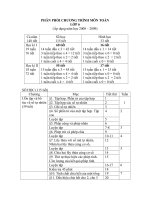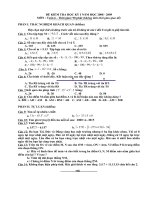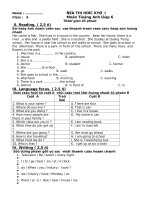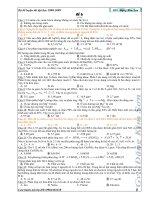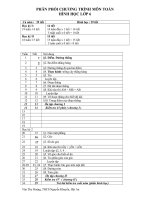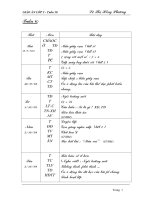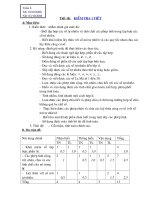Bsi bs en 01367 6 2008 (2009)
Bạn đang xem bản rút gọn của tài liệu. Xem và tải ngay bản đầy đủ của tài liệu tại đây (354.75 KB, 14 trang )
BRITISH STANDARD
Tests for thermal and
weathering properties
of aggregates
Part 6: Determination of resistance to
freezing and thawing in the presence
of salt (NaCl)
ICS 91.100.15
NO COPYING WITHOUT BSI PERMISSION EXCEPT AS PERMITTED BY COPYRIGHT LAW
BS EN
1367-6:2008
BS EN 1367-6:2008
National foreword
This British Standard is the UK implementation of EN 1367-6:2008.
The UK participation in its preparation was entrusted to Technical
Committee B/502/6, Test methods.
A list of organizations represented on this committee can be obtained on
request to its secretary.
This publication does not purport to include all the necessary provisions
of a contract. Users are responsible for its correct application.
Compliance with a British Standard cannot confer immunity
from legal obligations.
This British Standard
was published under the
authority of the Standards
Policy and Strategy
Committee on 30 April
2009
© BSI 2009
ISBN 978 0 580 57338 5
Amendments/corrigenda issued since publication
Date
Comments
BS EN 1367-6:2008
EUROPEAN STANDARD
EN 1367-6
NORME EUROPÉENNE
EUROPÄISCHE NORM
July 2008
ICS 91.100.15
English Version
Tests for thermal and weathering properties of aggregates - Part
6: Determination of resistance to freezing and thawing in the
presence of salt (NaCl)
Essais pour déterminer les propriétés thermiques et
l'altérabilité des granulats - Partie 6: Résistance au geldégel au contact du sel
Prüfverfahren für thermische Eigenschaften und
Verwitterungsbeständigkeit von Gesteinskörnungen - Teil 6:
Beständigkeit gegen Frost-Tau-Wechsel in der Gegenwart
von Salz (NaCl)
This European Standard was approved by CEN on 21 June 2008.
CEN members are bound to comply with the CEN/CENELEC Internal Regulations which stipulate the conditions for giving this European
Standard the status of a national standard without any alteration. Up-to-date lists and bibliographical references concerning such national
standards may be obtained on application to the CEN Management Centre or to any CEN member.
This European Standard exists in three official versions (English, French, German). A version in any other language made by translation
under the responsibility of a CEN member into its own language and notified to the CEN Management Centre has the same status as the
official versions.
CEN members are the national standards bodies of Austria, Belgium, Bulgaria, Cyprus, Czech Republic, Denmark, Estonia, Finland,
France, Germany, Greece, Hungary, Iceland, Ireland, Italy, Latvia, Lithuania, Luxembourg, Malta, Netherlands, Norway, Poland, Portugal,
Romania, Slovakia, Slovenia, Spain, Sweden, Switzerland and United Kingdom.
EUROPEAN COMMITTEE FOR STANDARDIZATION
COMITÉ EUROPÉEN DE NORMALISATION
EUROPÄISCHES KOMITEE FÜR NORMUNG
Management Centre: rue de Stassart, 36
© 2008 CEN
All rights of exploitation in any form and by any means reserved
worldwide for CEN national Members.
B-1050 Brussels
Ref. No. EN 1367-6:2008: E
BS EN 1367-6:2008
EN 1367-6:2008 (E)
Contents
page
Foreword ................................................................................................................................................ 3
1
Scope .............................................................................................................................................. 4
2
Normative references .................................................................................................................... 4
3
Terms and definitions.................................................................................................................... 4
4
Principle .......................................................................................................................................... 5
5
Apparatus ....................................................................................................................................... 5
6
Sampling ......................................................................................................................................... 5
7
Test specimens .............................................................................................................................. 6
8
Procedure ....................................................................................................................................... 6
9
Calculation and expression of results ......................................................................................... 8
10
Test report................................................................................................................................... 8
Annex A (informative) Precision........................................................................................................... 9
Bibliography ........................................................................................................................................ 10
2
BS EN 1367-6:2008
EN 1367-6:2008 (E)
Foreword
This document (EN 1367-6:2008) has been prepared by Technical Committee CEN/TC 154
“Aggregates”, the secretariat of which is held by BSI.
This European Standard shall be given the status of a national standard, either by publication of an
identical text or by endorsement, at the latest by January 2009, and conflicting national standards shall
be withdrawn at the latest by January 2009.
Attention is drawn to the possibility that some of the elements of this document may be the subject of
patent rights. CEN [and/or CENELEC] shall not be held responsible for identifying any or all such
patent rights.
This European Standard is one Part in the EN 1367 series of European Standards under the general
title Tests for thermal and weathering properties of aggregates. The other parts are:
Part 1: Determination of resistance to freezing and thawing
Part 2: Magnesium sulphate test
Part 3: Boiling test for “Sonnenbrand basalt"
Part 4: Determination of drying shrinkage
Part 5: Determination of resistance to thermal shock
Test methods for other properties of aggregates will be covered by Parts of the following European
Standards:
EN 932
EN 933
EN 1097
EN 1744
EN 13179
Tests for general properties of aggregates
Tests for geometrical properties of aggregates
Tests for mechanical and physical properties of aggregates
Tests for chemical properties of aggregates
Tests for filler aggregate used in bituminous mixtures
According to the CEN/CENELEC Internal Regulations, the national standards organizations of the
following countries are bound to implement this European Standard: Austria, Belgium, Bulgaria,
Cyprus, Czech Republic, Denmark, Estonia, Finland, France, Germany, Greece, Hungary, Iceland,
Ireland, Italy, Latvia, Lithuania, Luxembourg, Malta, Netherlands, Norway, Poland, Portugal, Romania,
Slovakia, Slovenia, Spain, Sweden, Switzerland and the United Kingdom.
3
BS EN 1367-6:2008
EN 1367-6:2008 (E)
1
Scope
This European Standard specifies a method of assessing the frost resistance of an aggregate when it
is subjected to the cyclic action of freezing and thawing in the presence of 1 % solution of NaCl in
de-ionized or distilled water.
The results of this test provide a means for assessing an aggregate’s resistance to this form of
weathering in areas where frequent freeze-thaw cycling occurs with seawater sprays or abundant deicers conditions, and where result values of EN 1367-1 test method do not describe correctly
aggregate performance in extreme conditions.
This European Standard gives the option to control the thawing sequence either by immersion in water
or by using air circulation in the low temperature cabinet to obtain the required reference temperature.
This test method is applicable to coarse aggregates or to coarse aggregates' fractions of all-in
materials. This method is not appropriate for lightweight aggregates covered by EN 13055 or
aggregates which can not be submitted to 110 °C oven drying.
2
Normative references
The following referenced documents are indispensable for the application of this document. For
undated references, the latest edition of the referenced document (including any amendments)
applies.
EN 932-1, Tests for general properties of aggregates — Part 1: Methods for sampling
EN 932-2, Tests for general properties of aggregates — Part 2: Methods for reducing laboratory
samples
EN 932-5, Tests for general properties of aggregates — Part 5: Common equipment and calibration
EN 933-1, Tests for geometrical properties of aggregates — Part 1: Determination of particle size
distribution — Sieving method
EN 933-2, Tests for geometrical properties of aggregates — Part 2: Determination of particle size
distribution — Test sieves, nominal size of apertures
3
Terms and definitions
For the purpose of this document, the following terms and definitions apply.
3.1
constant mass
successive weighings of the test specimen, after drying it, of at least 1 h apart, not differing by more
than 0,1 %
NOTE In many cases constant mass can be achieved after a test specimen has been dried for a predetermined period in a ventilated drying oven at (110 ± 5) °C.
3.2
reference temperature
temperature of the test specimen measured at the reference temperature measuring point
4
BS EN 1367-6:2008
EN 1367-6:2008 (E)
3.3
reference temperature measuring point
temperature at the centre of the covered can, filled with a test specimen and 1 % NaCl solution and
situated in the centre of the cooled area of the low temperature cabinet
4
Principle
The frost resistance of the aggregate is determined by subjecting it to the cyclic action of freezing and
thawing in the presence of salt (NaCl). The aggregate is soaked at atmospheric pressure and stored in
1 % NaCl solution for thorough absorption of the solution (see 8.1) and exposed to freezing under 1 %
NaCl solution (see 8.2).
Three test specimens of a single sized aggregate, having been soaked in 1 % NaCl solution at
atmospheric pressure, are subjected to 10 freeze-thaw cycles. This involves cooling to -17,5 ºC under
the 1 % NaCl solution and then thawing to 20 ºC. After completion of the freeze-thaw cycles, the
freeze-thaw resistance of the aggregate, as measured by the proportion of aggregate passing through
the d/2 sieve as sieved from the test specimen, is considered separately for each test specimen and
then expressed as a mean percentage by mass.
5
Apparatus
5.1
All apparatus, unless otherwise stated, shall conform to the general requirements of
EN 932-5.
5.2
Ventilated drying oven, thermostatically controlled to maintain a temperature of (110 ± 5) °C.
5.3
Balance, readable to ± 0,1 g, of sufficient capacity.
5.4
Low temperature cabinet, (upright or chest) with air circulation. The cabinet shall be
automatically controlled to adhere to the temperature curve shown in Figure 1. The test specimen
temperature in the thawing phase may be controlled by either air circulation or immersion in water. Any
manual method of control may be used, provided the correct temperature curve for the reference
temperature measuring point, as shown in Figure 1, is adhered to.
5.5
Cans, made from corrosion-resistant sheet metal, with a thickness of about 0,6 mm, having a
nominal capacity of 2 000 ml, an internal diameter of 120 mm to 140 mm, and an internal height of
170 mm to 220 mm. Cans shall be covered with lids.
5.6
Test sieves, conforming to EN 933-2.
5.7
1 % NaCl solution, made by mixing 20,0 g of NaCl of analytical grade in 1 980 g of de-ionized
or distilled water and making up to 2 000 g of the solution.
6
Sampling
Sampling shall be carried out in accordance with EN 932-1.
5
BS EN 1367-6:2008
EN 1367-6:2008 (E)
7
7.1
Test specimens
General
The preferred size fraction of the test specimen shall be within the range 8 mm (d) to 16 mm (D). If the
product size is smaller than 8 mm, a size fraction of 4 mm to 8 mm may be used.
Three individual test specimens shall be used. The test specimens shall be obtained in accordance
with EN 932-2 by sample reduction. Particles retained on “D” sieve or passing “d” sieve shall be
removed.
7.2
Mass of test specimens
The quantities for each of the three individual test specimens are specified in Table 1. Deviations of
± 5 % are permissible.
Table 1 — Mass of test specimens
Size fraction (d to D)
(mm)
8 to 16
4 to 8
7.3
Mass of test specimen (g)
2 000
1 000
Preparation of test specimens
The test specimens shall be washed according to EN 933-1 on the 8 mm sieve (or 4 mm sieve if the
smaller size fraction is used). They shall be dried to constant mass at (110 ± 5) °C, according to
EN 933-1 and allowed to cool to room temperature and weighed immediately (M1) to the nearest 0,1 g.
8
8.1
Procedure
Soaking
Store the test specimens prepared in accordance with 7.3 for (24 ± 1) h in the cans at (20 ± 3) °C. Add
the 1 % NaCl solution, and cover the test specimen by at least 10 mm for the full 24 h period of
soaking.
8.2
Exposure to freezing under 1 % NaCl solution
Check that the 1 % NaCl solution level in each can is still at least 10 mm above the top of the test
specimen and place the lids on the cans. Place the covered cans containing the test specimens in the
low temperature cabinet, ensuring that the distance between the cans and the sidewalls of the cabinet
is not less than 50 mm and the cans are not touching, in order that the heat is extracted from them as
uniformly as possible from all sides.
Use the reference temperature measuring point (see Clause 3) to regulate the low temperature
cabinet so that the reference temperature follows a temperature curve inside the limits shown in
Figure 1.
NOTE If desired, more than one reference temperature measuring point may be used, distributed at different
levels in the cabinet, to increase the accuracy of the temperature control.
6
BS EN 1367-6:2008
EN 1367-6:2008 (E)
Subject the test specimens in the cans in the low temperature cabinet to a series of 10 freeze-thaw
cycles as follows:
a) Reduce the temperature from (20 ± 3) °C to (- 1,0 ± 0,5) °C in (150 ± 30) min and hold at
(- 1,0 ± 0,5) °C till (360 ± 30) min from the beginning of the cycle;
b) Reduce the temperature from (- 1,0 ± 0,5) °C to reach (- 17,5 ± 2,5) °C (540 ± 30) min after the
beginning of the cycle and hold at (- 17,5 ± 2,5) °C for a minimum of 240 min.
If the test needs to be interrupted, when under manual control for example at weekends, the cans
shall be kept at (-17,5 ± 2,5) °C. The total interruption shall not exceed 72 h;
c) At no stage allow the temperature of the air in the cabinet to fall below - 22 °C;
d) After the completion of each freezing phase, thaw the cans by immersion in water or by using air
circulation in the cabinet until the reference temperature has reached (20 ± 3) °C;
e) After the completion of each thawing phase hold the cans at (20 ± 3) °C for a maximum of 10 h and
a minimum of 1 h. Each freeze-thaw cycle shall be completed within 24 h (except when interruption
occurs according to 8.2 b).
On completion of the tenth cycle, pour the contents of each can into a test sieve having an aperture
size that is half the lower size sieve used to prepare the test specimen (e.g. in the case of the 8 mm to
16 mm size fraction, into a test sieve of 4 mm aperture size). Wash and sieve the test specimen on
the specified sieve by hand. Dry the residue remaining on the sieve at (110 ± 5) °C to constant mass,
cool to ambient temperature and weigh immediately (M2) to the nearest 0,1 g.
Key
X Time (min)
Y Temperature (°C)
Figure 1 — Temperature curve with tolerance limits for the reference temperature
measuring point(s)
7
BS EN 1367-6:2008
EN 1367-6:2008 (E)
9
Calculation and expression of results
For each test specimen, calculate the result of the freeze-thaw test (F), to the nearest 0,1 % by mass,
in accordance with the following equation:
F=
M1 − M 2
⋅ 100
M1
where
M1
M2
F
is the initial dry mass of the test specimen, in grams;
is the final dry mass of the test specimen that is retained on the sieve specified in 8.2,
in grams;
is the percentage loss in mass of the test specimen after freeze-thaw cycling.
Calculate FNaCl as the mean of the three individual test results, to the nearest %.
NOTE
10
A statement on the precision of this test is given in Annex A.
Test report
The test report shall include the following information:
a) a reference to this European Standard, i.e. EN 1367-6;
b) the sampling method and marking, designation and origin of the laboratory sample;
c) the size fraction of the test specimens;
d) the result of the freeze-thaw test, F, for each test specimen;
e) the test result FNaCl ;
f) the date of the test report and name of the test laboratory;
g) any unusual disintegration of the aggregate retained on the sieve at the end of the test.
8
BS EN 1367-6:2008
EN 1367-6:2008 (E)
Annex A
(informative)
Precision
The following precision data was determined from a cross-testing project involving normal weight
aggregates from 18 sources, tested at 15 laboratories in 10 European countries (FRAS, Nordtest
project No. 1624-03). The aggregates were chosen to cover a range of aggregate types and
performances.
The results were interpreted in accordance with ISO 5725-2:1994 and are as followed:
Table A.1 — Repeatability calculations
Outliers deleted
Repeatability standard
deviation (sr)
Correlation
coefficient (r)
sr = 0,048X + 0,215
0,76
NOTE X is the FNaCl value.
Table A.2 — Reproducibility calculations
Outliers deleted
Reproducibility
standard deviation (sR)
Correlation
coefficient (r)
sR = 0,676X + 0,674
0,85
NOTE X is the FNaCl value.
The repeatability (r), and the reproducibility (R) can be retrieved by multiplying the sr and sR,
respectively, with the factor 2,78.
9
BS EN 1367-6:2008
EN 1367-6:2008 (E)
Bibliography
[1]
EN 13055 (all parts), Lightweight aggregates
[2]
ISO 5725-2:1994, Accuracy (trueness and precision) of measurement methods and results —
Part 2: Basic method for the determination of repeatability and reproducibility of a standard
measurement method
[3]
PETURSSON, P. & SCHOUENBORG, B. 2004: Frost resistance test on aggregates with and
without salt (FRAS), Nordtest project no.1624-03
10
BS EN 1367-6:2008
This page has been intentionally left blank
BS EN
1367-6:2008
BSI - British Standards Institution
BSI is the independent national body responsible for preparing British
Standards. It presents the UK view on standards in Europe and at the
international level. It is incorporated by Royal Charter.
Revisions
British Standards are updated by amendment or revision. Users of British
Standards should make sure that they possess the latest amendments or
editions.
It is the constant aim of BSI to improve the quality of our products and services.
We would be grateful if anyone finding an inaccuracy or ambiguity while using
this British Standard would inform the Secretary of the technical committee
responsible, the identity of which can be found on the inside front cover. Tel:
+44 (0)20 8996 9000. Fax: +44 (0)20 8996 7400.
BSI offers members an individual updating service called PLUS which ensures
that subscribers automatically receive the latest editions of standards.
Buying standards
Orders for all BSI, international and foreign standards publications should be
addressed to Customer Services. Tel: +44 (0)20 8996 9001. Fax: +44 (0)20 8996
7001 Email: You may also buy directly using a debit/credit
card from the BSI Shop on the Website />In response to orders for international standards, it is BSI policy to supply the
BSI implementation of those that have been published as British Standards,
unless otherwise requested.
Information on standards
BSI provides a wide range of information on national, European and
international standards through its Library and its Technical Help to Exporters
Service. Various BSI electronic information services are also available which
give details on all its products and services. Contact Information Centre. Tel:
+44 (0)20 8996 7111 Fax: +44 (0)20 8996 7048 Email:
Subscribing members of BSI are kept up to date with standards developments
and receive substantial discounts on the purchase price of standards. For details
of these and other benefits contact Membership Administration. Tel: +44 (0)20
8996 7002 Fax: +44 (0)20 8996 7001 Email:
Information regarding online access to British Standards via British Standards
Online can be found at />Further information about BSI is available on the BSI website at http://
www.bsigroup.com.
Copyright
BSI Group
Headquarters 389
Chiswick High Road,
London, W4 4AL, UK
Tel +44 (0)20 8996 9001
Fax +44 (0)20 8996 7001
www.bsigroup.com/
standards
Copyright subsists in all BSI publications. BSI also holds the copyright, in the
UK, of the publications of the international standardization bodies. Except as
permitted under the Copyright, Designs and Patents Act 1988 no extract may
be reproduced, stored in a retrieval system or transmitted in any form or by any
means – electronic, photocopying, recording or otherwise – without prior written
permission from BSI.
This does not preclude the free use, in the course of implementing the standard,
of necessary details such as symbols, and size, type or grade designations. If
these details are to be used for any other purpose than implementation then the
prior written permission of BSI must be obtained.
Details and advice can be obtained from the Copyright and Licensing Manager.
Tel: +44 (0)20 8996 7070 Email:
